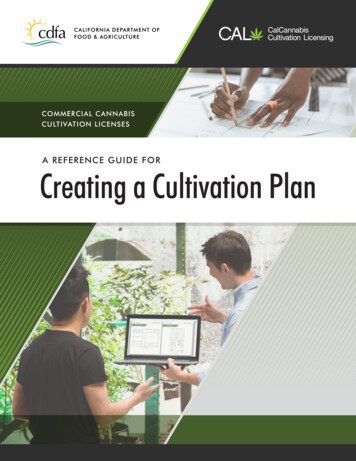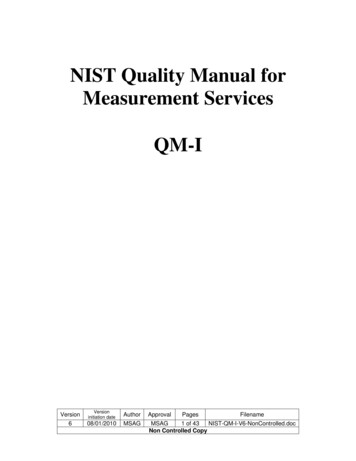
Transcription
CALIFORNIA DEPARTMENT OFFOOD & AGRICULTURECOMMERCIAL CANNABISCULTIVATION LICENSESA REFERENCE GUIDE FORICreating a Cultivation Plan;/
CALIFORNIA DEPARTMENT OFFOOD & AGRICULTUREICal CannabisCultivation LicensingCalCannabis Cultivation Licensing, a division of the California Department of Food andAgriculture, created this document to provide guidance on how to create the cultivation planrequired to be submitted with each cannabis cultivation licensing application. This documentis for informational purposes and is not the official state application, nor does it include all theapplication requirements. For the official state application for a commercial cannabis cultivationlicense, please visit the CalCannabis website: calcannabis.cdfa.ca.gov.Updated 10/30/19A REFERENCE GUIDE FOR CREATING A CULTIVATION PLAN2
CALIFORNIA DEPARTMENT OFFOOD & AGRICULTUREICA IL "' CalCannabisCultivation LicensingCULTIVATION PLAN REQUIREMENTSCultivation plan requirements vary based on the type of cannabis cultivation license one isapplying for, and the plan requirements are outlined by license type below. Each cultivation planrequirement has a corresponding section in this document that introduces the requirement,provides examples, and, where applicable, offers optional templates that applicants may use.SPECIALTY COTTAGE, SPECIALTY, SMALL, AND MEDIUM LICENSE TYPES Lighting Diagram (mixed-light and indoor licenses only)Pest-Management PlanPremises DiagramProperty DiagramWaste-Management PlanNURSERY LICENSE Pest-Management PlanPremises DiagramProperty DiagramWaste-Management PlanPROCESSOR LICENSE Premises DiagramProperty DiagramWaste-Management PlanA REFERENCE GUIDE FOR CREATING A CULTIVATION PLAN3
CALIFORNIA DEPARTMENT OFFOOD & AGRICULTUREICal CannabisCultivation LicensingGLOSSARY OF KEY TERMSBrief definitions of key words and terms used in the state of California’s cannabis cultivationlicensing application are outlined below. For more in-depth definitions, please review theCalifornia Department of Food and Agriculture’s cannabis cultivation regulations and Businessand Professions Code Division 10, which are posted on the CalCannabis Cultivation Licensingwebsite at calcannabis.cdfa.ca.gov.Administrative-Hold Area: A designated area for all segregated cannabis or nonmanufacturedcannabis products subject to being put on hold.Canopy: The designated area(s) at a licensed premises (except for nurseries and processors) thatwill contain mature (flowering) plants at any point in time, as follows: A specialty outdoor canopy is determined by either square feet or plant count, whereas aspecialty cottage outdoor canopy is determined by plant count. If mature plants are being cultivated using a shelving system, the surface area of eachlevel must be included in the total calculation of the canopy. The canopy shall be calculated in square feet and measured using clearly identifiableboundaries of all the areas that will contain mature plants at any point in time, includingall the space(s) within the boundaries. The canopy may be noncontiguous, but each unique area included in the total canopycalculation must be separated by an identifiable boundary that includes, but is notlimited to, interior walls, shelves, greenhouse walls, hoop-house walls, garden benches,hedgerows, fencing, garden beds, or garden plots.Composting Area: The area designated for composting on the licensed premises.Cultivation Plan: A component of the licensing application that may include a premises diagram,pest-management plan, and waste-management plan, depending on the license type.Flowering: A cannabis plant that has formed a mass of pistils measuring more than one-half-inchwide at its widest point.Harvest Storage Area: The area designated in the cultivation plan for storing all harvestedcannabis on the licensed premises.Immature Plant: A cannabis plant that has a first true leaf measuring more than one-half-inchlong from base to tip (if started from seed), or a mass of roots measuring more than one-halfinch wide at the widest point (if vegetatively propagated) that is not yet flowering.A REFERENCE GUIDE FOR CREATING A CULTIVATION PLAN4
CALIFORNIA DEPARTMENT OFFOOD & AGRICULTUREICal CannabisCultivation LicensingGLOSSARY OF KEY TERMSIndoor Cultivation: Cultivation of cannabis within a permanent structure using artificial lightexclusively, or within any type of structure using artificial light at a rate above 25 watts persquare foot.Lighting Diagram: A plan that identifies the location of all lights in the canopy area(s) and themaximum wattage, or wattage equivalent, of each light. Note: This applies to mixed-light andindoor license types only.Mature Plant: A cannabis plant that is flowering.Mixed-Light Cultivation: Cultivation of mature cannabis in a greenhouse, hoop-house,glasshouse, conservatory, hothouse, or similar structure, using a combination of:(1) Natural light, light deprivation, and one of the following artificial-lighting models:(A) “Mixed-Light Tier 1” is without the use of artificial light—or using artificial light at arate above zero, but not more than six watts per square foot;(B) “Mixed-Light Tier 2” is using artificial light at a rate above six watts per square footand below or equal to 25 watts per square foot; or(2) Natural light and one of the following artificial-lighting models:(A) “Mixed-Light Tier 1” is using artificial light at a rate above zero watts, but no morethan six watts per square foot;(B) “Mixed-Light Tier 2” is using artificial light at a rate above six watts per square footand below or equal to 25 watts per square foot.Outdoor Cultivation: Cultivation of mature cannabis without using artificial lighting or lightdeprivation in the canopy area at any time; artificial lighting is permissible only to maintainimmature plants outside the canopy area.Packaging Area: The area designated for packaging cannabis on the licensed premises.Pesticide and Agricultural-Chemical Storage Area: The area designated to store all chemicalsthat will be used on the licensed premises.Pest-Management Plan: A plan that identifies the biological, cultural, and chemical removal ofpests; this plan must include the product names and active ingredients of all the pesticides thatwill be used on cannabis.Premises: The designated structure or structures, and the land specified in the cannabis licenseapplication, that is owned, leased, or otherwise held under the control of the applicant orlicensee where the commercial cannabis activity will be conducted; the premises shall be acontiguous area and only occupied by one licensee.A REFERENCE GUIDE FOR CREATING A CULTIVATION PLAN5
CALIFORNIA DEPARTMENT OFFOOD & AGRICULTUREICal CannabisCultivation LicensingGLOSSARY OF KEY TERMSProcessing Area: The area designated for the processing of cannabis on the licensed premises;processing includes drying, curing, grading, trimming, rolling, storing, packaging, and labeling ofnonmanufactured cannabis products.Research and Development Area: The area identified in the cultivation plan for a nurserylicense; this is the area that will be used for research and development that requires a cannabisplant to flower. All products derived from these plants are prohibited from entering thecommercial distribution chain. Note: This applies to nursery licenses only.Seed Production Area: The area designated for cannabis seed production for a nursery license;this area may contain mature plants, and seeds are the only product allowed to enter thecommercial distribution chain from this designated area. Note: This applies to nursery licensesonly.Waste-Management Plan: A plan that identifies how cannabis waste generated on the licensedpremises is managed.Watts per Square Foot: The sum of the maximum wattage of all lights identified in thedesignated canopy area(s) in the cultivation plan, divided by the sum of the dimensions insquare feet of the designated canopy area(s) identified in the cultivation plan.A REFERENCE GUIDE FOR CREATING A CULTIVATION PLAN6
CALIFORNIA DEPARTMENT OFFOOD & AGRICULTUREICA IL "' CalCannabisCultivation LicensingPROPERTY DIAGRAMA property diagram is an illustration of the entire property (the bird’s-eye view) associated withthe proposed premises. If the proposed premises span multiple parcels, all parcel numbers mustbe identified on the diagram.The property diagram requirements are the same for all license types. A complete diagramincludes: All roads and water crossings (including seasonal streams) All water sources, which must be identified and labeled for their type of beneficial use,including, but not limited to, irrigation, domestic, fire protection, power, fish and wildlifepreservation and enhancement, and/or recreation Assessor’s Parcel Number(s) (APN) Designated shared areas Entrances to the property and premises Exits from the property and premises If proposing a water source for cultivation that uses a diversion from a waterbody or anunderground stream flowing in a known and definite channel, groundwater well, or raincatchment system, include the following locations on the property diagram, in additionto coordinates in either latitude and longitude or from the California Coordinate System: Water storage unit(s) (label the type and storage capacity of each unit) Water source(s) for cannabis irrigation; and If the proposed premises consists of only a portion of the property, the diagrammust be labeled to indicate which part of the property is the proposed premisesand how the remaining property is used Premises boundaries and dimensions Property boundaries and dimensions Water-distribution system(s)—from water source to water storage—for cannabisirrigation, including pumpsIn addition to the list above, a property diagram must be to scale, and there may not be anyhighlighting. Please see the sample property diagram on the following page.A REFERENCE GUIDE FOR CREATING A CULTIVATION PLAN7
. . ;.,,.-·.A REFERENCE GUIDE FOR CREATING A CULTIVATION PLAN818’---- ----.I/Property BoundaryEntrance and Exit toProperty and 5’ICannabis FarmAPN: 000-000-000-0001,315’Entrance and Exit toProperty and PremisesCommercial CannabisPremises BoundaryEntrance and Exit toProperty and PremisesI' ' . I . .'L .,. If . . : .·t. . '. ';.l":.',. '',,.'.:.' III·: -, J. . r, .I- : t.,. .' --Aerial imagery and a basic image-editing software program were used tolabel each property diagram accurately.102’100’Non-CannabisAgricultural ProductsAesthetic PondEntranceand gk SlaOtWes1WaterCrossingDrwiveayFour 1,500-GallonWater-Storage Tanks38.1266, 122.6554If '·:County Roa,d2Domestic WellWater-Distribution LineAgricultural WellPROPERTY DIAGRAMCounty Road 1CALIFORNIA DEPARTMENT OFFOOD & AGRICULTURECal CannabisCultivation LicensingSINGLE CULTIVATION PREMISES8
ICALIFORNIA DEPARTMENT OFFOOD & AGRICULTUREPROPERTY DIAGRAMCal CannabisCultivation LicensingMULTIPLE CULTIVATION PREMISESProperty andPremises rries)Agricultural Well:34.1236, 119.4321Three 10,000-GallonWater-Storage Tanks34.1236, A REFERENCE GUIDE FOR CREATING A CULTIVATION PLAN1,470’County Road 551,360’GreenhouseEntrance and ExitEntrance and Exitto Property andPremisesCannabis FarmAPN: 000-000-000-0009
CALIFORNIA DEPARTMENT OFFOOD & AGRICULTUREICA IL "' CalCannabisCultivation LicensingPREMISES DIAGRAMA premises diagram is a bird’s-eye-view illustration of the proposed premises; requirements varybased on the type of license. Boundaries and dimensions (in feet) of the required areas must beidentified, as specified below.SPECIALTY COTTAGE, SPECIALTY, SMALL, AND MEDIUM LICENSE TYPE REQUIREMENTSAreas marked with “if applicable” must be identified if they occur on the site. “If applicable”areas occurring off-site may be identified on the optional template on page 12 or directly on thediagram. Areas containing only immature plants (if applicable) Common-use area(s), such as hallways, bathrooms, or break roomsCanopy areas; include aggregate square footage if the canopy areas arenoncontiguousComposting area (if applicable)Designated administrative-hold areaHarvest storage areaPesticide and agricultural-chemical storage areaProcessing area (if applicable)Packaging area (if applicable)Secure cannabis-waste-storage area (if applicable)NURSERY LICENSE REQUIREMENTS At least one of the following areas: Areas containing only immature plants Seed production area (if applicable)Composting area (if applicable)Pesticide and agricultural storage areaResearch and development area (if applicable)Secure cannabis-waste-storage area (if applicable)A REFERENCE GUIDE FOR CREATING A CULTIVATION PLAN10
CALIFORNIA DEPARTMENT OFFOOD & AGRICULTUREPREMISES DIAGRAMICal CannabisCultivation LicensingAREAS MARKED “IF APPLICABLE”PROCESSOR LICENSE REQUIREMENTS Composting area (if applicable)Harvest storage areaPackaging area (if applicable)Processing areaSecure cannabis-waste-storage area (if applicable)In addition to the items listed above, a premises diagram must be to scale. Please see thesample premises diagrams on pages 13, 18, and 19.CalCannabis has created an optional template, available on page 12, that applicants may use toidentify off-site activities.A REFERENCE GUIDE FOR CREATING A CULTIVATION PLAN11
CALIFORNIA DEPARTMENT OFFOOD & AGRICULTUREPREMISES DIAGRAMICal CannabisCultivation LicensingOPTIONAL TEMPLATEACTIVITIES TO BE PERFORMED OFF-SITE INCLUDE: For Specialty Cottage, Specialty, Small, and Medium Licenses (check all that apply) Immature plant growth Packaging Processing For Nursery Licenses (check all that apply) Immature plant growth Research and development with flowering cannabis plants Seed production with flowering cannabis plants For Processor Licenses (check if applicable) PackagingA REFERENCE GUIDE FOR CREATING A CULTIVATION PLAN12
ICALIFORNIA DEPARTMENT OFFOOD & AGRICULTUREPREMISES DIAGRAMCal CannabisCultivation LicensingMULTIPLE CULTIVATION PREMISESOff-Site Activities Include:- Immature Plants- Packaging- ProcessingPremises Diagram for Small Mixed-Light Tier 1(Aggregate Square Footage of Canopy: 7,812)36’100’MediumMixed-LightTier 1 CanopyStorage AreaDiagram on theNext PageSmall Mixed-LightTier 1 Canopy217’Multiple premises are permitted to be on one property, but only licenses held bythe same licensee may share spaces. For “if applicable” areas, please clarify on thediagram whether they will occur on-site or off-site.A REFERENCE GUIDE FOR CREATING A CULTIVATION PLAN13
ICALIFORNIA DEPARTMENT OFFOOD & AGRICULTUREPREMISES DIAGRAMCal CannabisCultivation LicensingMULTIPLE CULTIVATION PREMISESStorage Area Diagram(detail from page 13)Shared Cannabis-WasteStorage Area!50’Harvest Storage Area andAdministrative-Hold Area10’Medium Mixed-Light Tier 115’ by 50’5’30’Harvest Storage Area andAdministrative-Hold AreaSmall Mixed-Light Tier 115’ by 50’5’5’Shared Pesticide andAgricultural-ChemicalStorage AreaThis sample diagram shows two cultivation premises on one property.A REFERENCE GUIDE FOR CREATING A CULTIVATION PLAN14
CALIFORNIA DEPARTMENT OFFOOD & AGRICULTUREPREMISES DIAGRAMICA IL "' CalCannabisCultivation LicensingMULTIPLE CULTIVATION PREMISESAREAS THAT MAY NOT BE SHARED CanopyDesignated administrative-hold areaHarvest storage areaImmature-plant area (if applicable)Packaging area (if applicable)Processing area (if applicable)AREAS THAT MAY BE SHARED IF MULTIPLE LICENSES ARE HELD BY ONE LICENSEE Cannabis-waste area (if applicable)Common-use areas, such as hallways, break rooms, or bathroomsCompost area (if applicable)Pesticide and agricultural-chemical storage areaA REFERENCE GUIDE FOR CREATING A CULTIVATION PLAN15
CA IL "' CALIFORNIA DEPARTMENT OFFOOD & AGRICULTURECalCannabisCultivation LicensingPREMISES DIAGRAMHAND-DRAWN SMALL OUTDOORCULTIVATION PREMISESPesticide and t\3ricultural Chemical Stora3e t\reaCannabis l-lal'Vest Stol'ct.9e andAdn1inistl'ative-l-lold Al'ea\Compostt\rea \ 20R\/':J30 I]20RSn1all Outdool' Pl'en1ises- illlllldture Pldnts ObtdinedOtt-Site- Pdckdjirlj Ott-Site- ProceSSirlj Ott-Site20RPrivate RoadHand-drawn diagrams are permissible if they are legible and meet all requirements.If the canopy is noncontiguous, all mature cannabis must be contained within theidentified canopy boundaries.A REFERENCE GUIDE FOR CREATING A CULTIVATION PLAN16
ICALIFORNIA DEPARTMENT OFFOOD & AGRICULTUREPREMISES DIAGRAMCal CannabisCultivation LicensingMEDIUM OUTDOORCULTIVATION PREMISESOutdoor Canopy (Aggregate Square Footage of Canopy: 24,302)Compost Area25’25’229’Outdoor Canopy50’Outdoor Canopy238’Pesticide and AgriculturalChemical-Storage Area25’30’18’ 12’AdministrativeHold cessing Area, Packing Area, andCannabis Harvest Storage AreaA REFERENCE GUIDE FOR CREATING A CULTIVATION PLAN17
ICALIFORNIA DEPARTMENT OFFOOD & AGRICULTUREPREMISES DIAGRAMCal CannabisCultivation LicensingPROCESSOR ’L)\JEmployeeBreak RoomLobby50’850’1,070’1,200’ 975’Processing AreaPackaging Area400’1,200’1050’ic145’" 850’Cannabis Harvest StorageCannabis-Waste-Storage Area80’I\150’1,400’A software-editing program was used to create this samplepremises diagram for a processor license.A REFERENCE GUIDE FOR CREATING A CULTIVATION PLAN18
7’A software-editing program was used to create this samplepremises diagram for a nursery license.26’Seed Production Areall;'·. . ,--.,/RestroomChemicalStorage.,.WasteArea. ,i4.5’-",I.,//-1/ :: ·.:-:,-- ,./--- ,Office.,. "/ -i ./r./' '·7’. .».,,fi.-,--.J,.,7’--i'".-.12’.I.,I\.'.(- .;.: - /,. . .;;,ImmaturePlant Area. ,.: 1/ .-:.-.-:z12’.-"-1 .h1/.r,I/,1 :. 1.1'/,'l {·'l I/ '.{ .-',' '.{ . . ,Hr/,« z ,,,;,1///.-'Research andDevelopmentArea30’. ,.,.;/,; /-1/« i;,y.;Immature-Plant Area'/,;·'/ ?,": j1/ .,.- -:: ;/,·.,, ·/,: // , , .,,. ,;, /,-- ,:1::- ·,;:. 4 ½ {' /,. 1/,- 1/.,, .15’-",I.,. ,. .,.,,.'/,.,;--i'".-1 { '{ » 1 1 a7 {' {' . , ., ,:;, 7 ·8:,. « ·/, /,-- /4 · ';, '.(- .;/2 / 1 ·{1 1 .;- ;-1/ 7 j -8: V 7 .;, , .; ·/,' 7 1/,,' 'q/4k«/,--'l /,-- &-;-'.·,; .I/ {,.,.,/,;.-: ./.;,:h - - '.;-;:-;;-:;;;;,;:,-;·, % /,' % -;.:; 1/ ·;.-;,.· « -:; . .,., ;,;, '1/· 1/, .,., './/- -1/ -'.,, /,' / /,, ,:".-' . ; . . -1/ // ,:".-' .;,, -1/ ,:. . , . ., ·,// .;-.z.; 1/,--«Z ½z.;-.½.;- 1/,--½½ ? 1/,-- //,-- ;;;- .;: ,.,., -:,; ;,:. ,;. /,: {' ;,:. /; ?-· /,-- .;: ,.,., ,-:,; ;,:. ,;. /,: , ,. ,,.; ;,,. ,;, /,-- ,.,,.--:,;: {' {'/,-- ,,· .,, ., .,15’30’CC)Q)C"iii -QS:2(/)".J.0 CC1tjCll (.) :pcu "3(.)(.) ./,/,;",: { :,, / ., /, / ., .·· - \ ;" .,.- - ,; « .v 1' ½ .;- ½ 0 :.// .;,., ;- ? .// .;,, -/ '". , {' {' -1/ 1/, j 1 /2 .;.,., -'.,; {;· ·1/ -Z· ,-1/ /:: -1/ ½ // ¼ h .,-, /2 -'.Z -Xf{Y-7 /-1/ 17 1' .;- ½ j % ,;:,- -½ ;:; ?,:"/ ?' ? .// .;,, ;, ;, ;,., ,i /.,, ., .,/,-- 1/,-, ,Z .;-.z.; 1/,--«Z ½z.;-.½.5 -1/ .::, . ·:(. . -:,; ;,:. ,. ; .:;- {' ;,:. 1 ?-· -1/ ·:(. (/ -:,; ;,:. '.,/1/,--:{1/,{' ,;:.4;-:.,:.-;;;;., ., .,., .1/,{'19A REFERENCE GUIDE FOR CREATING A CULTIVATION PLAN )"u.01-w wz ""WU0. : ) .I- :)"" I "" c.,0-z o""ell::::;o ou u. ( /'' }PREMISES DIAGRAMNURSERY LICENSE
CALIFORNIA DEPARTMENT OFFOOD & AGRICULTUREICal CannabisCultivation LicensingPEST-MANAGEMENT PLANTraditionally, pest-management plans are implemented with a focus on long-term managementand/or suppression of unwanted pests using cultural, biological, and chemical control measures.The pest-management plan submitted with a cannabis cultivation license application mustinclude, but is not limited to, the requirements listed below.The local county agricultural commissioner (CAC) is responsible for regulating pesticides in his orher county. CAC contact information is available online: cdfa.ca.gov/exec/county/countymap.All licensed cultivators must comply with the laws and regulations enforced by the CaliforniaDepartment of Pesticide Regulation and county agricultural commissioners. The CaliforniaDepartment of Food and Agriculture (CDFA) requires all applicants to sign an acknowledgementand attestation regarding pesticide usage. Please read, sign, and upload the attestation availableon the CDFA CalCannabis Cultivation Licensing Division website: calcannabis.cdfa.ca.gov.REQUIREMENTS A signed acknowledgement and attestation for pest-management activities Integrated pest-management protocols, including the following control methods: Biological Chemical Cultural Product name and the active ingredients of all pesticides that will be applied tocannabis during any stage of plant growth (for example, rooting hormones, pesticides,rodenticides, fungicides, etc.)CalCannabis has created an optional template that applicants may use to complete theirpest-management plan (see the following page).A REFERENCE GUIDE FOR CREATING A CULTIVATION PLAN20
CALIFORNIA DEPARTMENT OFFOOD & AGRICULTUREPEST-MANAGEMENT PLANICal CannabisCultivation LicensingOPTIONAL TEMPLATECultural pest-management-control methods, such as pulling weeds, irrigation practices,and sanitationBiological pest-management-control methods, such as natural predators like ladybeetles and lacewingsChemical pest-management-control methodsChemical(s) to be applied at any stage of plant growthProduct NameActive Ingredient(s)Attach additional sheets of paper, as needed.I have signed the Pesticide Acknowledgement and Attestation form posted on theCDFA CalCannabis Cultivation Licensing Division website at calcannabis.cdfa.ca.gov, anduploaded it to the application record. A REFERENCE GUIDE FOR CREATING A CULTIVATION PLAN21
CALIFORNIA DEPARTMENT OFFOOD & AGRICULTUREICA IL "' CalCannabisCultivation LicensingWASTE-MANAGEMENT PLANFor this section, cannabis waste is defined as organic waste, such as food waste, green waste,landscape and pruning waste, nonhazardous-wood waste, and food-soiled paper waste that ismixed with food waste. For cannabis cultivation license applications, a waste-management planmust identify all methods—from the allowable methods listed below—that will be used formanaging cannabis waste generated on the premises.WASTE-MANAGEMENT METHODS Collection and processing by a local agency, a waste-hauler franchised or contracted by alocal agency, or a private waste-hauler permitted by a local agency On-premises composting Self-hauling to one or more of the following:Reintroducing cannabis waste into an agricultural operation through on-premises organicwaste-recycling methods, including, but not limited to, tilling directly into agricultural landand no-till farming a manned and fully permitted solid-waste landfill or transformation facility a manned and fully permitted composting facility or manned composting operation a manned and fully permitted in-vessel digestion facility or manned in-vessel digestionoperation a manned and fully permitted transfer/processing facility or manned transfer/processing operation a manned and fully permitted chip-and-grind operation or facility a recycling center as defined in the California Code of Regulations, title 14, section17402.5(d), and that meets all the following: the cannabis waste received shall contain at least 90 percent inorganic material; the inorganic portion of the cannabis waste is recycled into new, reused, orreconstituted products that meet the quality standards necessary for use in themarketplace; and the organic portion of the cannabis waste shall be sent to one of the five facility oroperation types listed above in the self-hauling sectionCalCannabis has created an optional template that applicants may use to complete their wastemanagement plan (see the following page).A REFERENCE GUIDE FOR CREATING A CULTIVATION PLAN22
CALIFORNIA DEPARTMENT OFFOOD & AGRICULTUREWASTE-MANAGEMENT PLANICA IL "' CalCannabisCultivation LicensingOPTIONAL TEMPLATEMETHODS FOR MANAGING CANNABIS WASTE GENERATED ON A PREMISES MAY INCLUDE: Collection and processing by a local agency, a waste-hauler franchised or contractedby a local agency, or a private waste-hauler permitted by a local agency On-premises compostingSelf-hauling to one or more of the following: a manned and fully permitted solid-waste landfill or transformation facility a manned and fully permitted composting facility or manned compostingoperation a manned and fully permitted in-vessel digestion facility or manned in-vesseldigestion operation a manned and fully permitted transfer/processing facility or mannedtransfer/processing operation a manned and fully permitted chip-and-grind operation or facility a recycling center as defined in the California Code of Regulations, title 14, section17402.5(d), and that meets all the following: the cannabis waste received shall contain at least 90 percent inorganicmaterial; the inorganic portion of the cannabis waste is recycled into new, reused, orreconstituted products that meet the quality standards necessary for use inthe marketplace; and the organic portion of the cannabis waste shall be sent to one of the fivefacility or operation types listed above in the self-hauling sectionA REFERENCE GUIDE FOR CREATING A CULTIVATION PLAN23
cd.ca LI,'\ J CALIFORNIA DEPARTMENT oFFOOD & AGRICULTUREICAIL "' CalCannabisCultivation LicensingLIGHTING DIAGRAMApplications for indoor and mixed-light license types must include a lighting diagram; pleasesee the requirements outlined below. While not required, it is helpful to provide the aggregatewattage per square foot of each canopy.REQUIREMENTS Aggregate wattage per square foot of each canopy (recommendedbut not required) Location of all lights in the canopy area(s) Maximum wattage of each lightSAMPLE LIGHTING DIAGRAM FOR A MIXED-LIGHT TIER 2 LICENSECanopy Area 1Canopy Area 2@@@@@@@@@@@@@@@@@@@@@@@@@@@@@@Aggregate Wattage per Canopy AreaMaximum Wattage of Each Light15 lights X 1,200 watts per light 18,000 wattsEach canopy area (greenhouse) 1,500 square feet a 1,200 maximumwatt light18,000 watts 1,500 square feet 12 watts per square footA REFERENCE GUIDE FOR CREATING A CULTIVATION PLAN24
CALIFORNIA DEPARTMENT OFFOOD & AGRICULTURECal CannabisCultivation Licensing
Lighting Diagram: A plan that identifies the location of all lights in the canopy area(s) and the maximum wattage, or wattage equivalent, of each light. Note: This applies to mixed-light and indoor license types only. Mature Plant: A cannabis plant that is flowering. Mixed-Light Cultivation:











